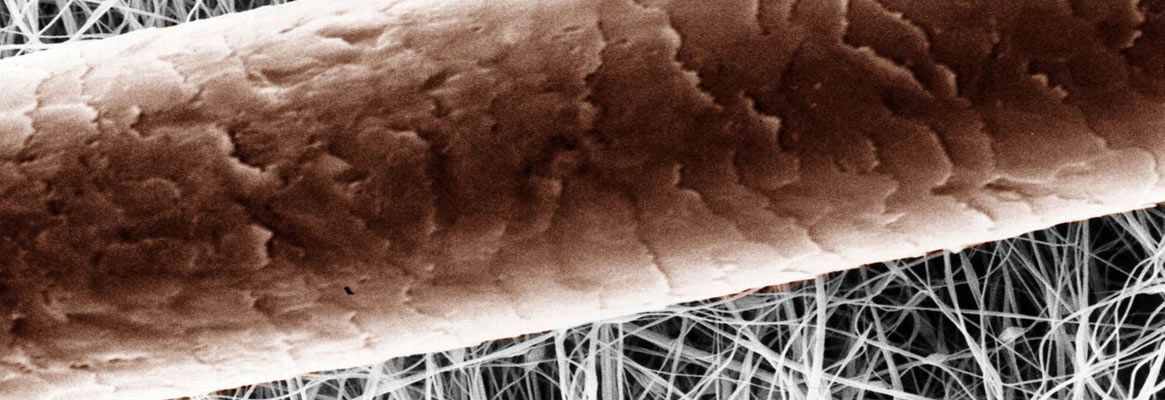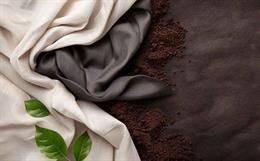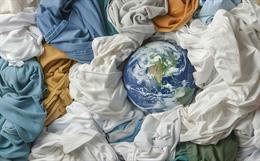| Nanotex protective treatment is the latest in textile finishing with wider application and has been proving to be a useful tool in improving the performance of textiles, affirms V Parthasarathi. |
Nanotechnology is an umbrella term covering a wide range oftechnologies concerned with structures and processes on the nanometre scale.Because of its potential to change fundamentally whole fields of technology,nanotechnology is regarded as a key technology, which will not only influencetechnological development in the near future, but will also have economic,social and ecological implications.
Nanotechnology deals with the science and technology atdimensions of roughly 1 to 100 nanometres (1 Billion Nanometres = 1 Metre),although 100 nanometres presently is the practically attainable dimension fortextile products and applications (2).
The technology can be used in engineering desired textileattributes, such as fabric softness, durability, and breath ability and indeveloping advanced performance characteristics, namely, water repellency, fireretardancy, antimicrobial resistance, etc in fibres, yarns and fabrics (1).
Enhancement of textile materials by nanotechnology isexpected to become a trillion dollar industry in the next decade, with tremendoustechnological, economic and ecologic benefits. It was estimated that for theyear 2003, the worldwide government funding for the research and development inthe area of nanotechnology had increased to $3 billion annually in addition tothe millions of dollars invested private industries(3) .
Although, textile industry is small part of the globalresearch in the emerging areas of nano-technology, the fibres and textilesindustries in fact were the first to have successfully implemented these advancesand demonstrated the applications of nanotechnology for consumer usage.
With the advent of nano technology, a new area has developedin the realm of textile finishing. Nan coating the surface of textiles,clothing, and textiles for footwear is one approach to the production of highlyactive surfaces to have UV-blocking, antimicrobial and self-cleaning properties.The self-cleaning property can be imparted by nano-TiO2/nano-ZnOcoating (6).
From functional to intelligent and smart textiles
Intelligent clothing is articles of clothing, footwear oraccessories that feature microelectronic sensors. Smart clothes are thecombination of intelligent and fashionable clothing. The required thermalinsulation of clothing system depends on the physical activity and on thesurrounding conditions. The quantity of heat produced by the body depends verymuch on the physical activity and can vary from 100 W while resting to over1,000 W during maximum activity. During the cooler seasons approximately 0 C,the recommended thermal insulation is defined in order to ensure that the bodyis sufficiently warm when resting (22).
At a more intensive activity, this is the case withsportsmen, the body temperature increases with enhanced heat production. Tokeep this increase within a certain limit, the body perspires in order towithdraw energy from the body by evaporative cooling. Intelligent textilesused to improve insulation are the phase change materials and the shape memorymaterials. The other main application of intelligent materials is the fashionfield, to create fantasy design thanks to the chromic materials. Some examplesof these are: Music T-Shirts, business garments, solar energy recharge jacket,and etc. integration of electronic technology into clothing means the start ofa whole new era in the fashion industry.
Existing functional materials on the market are waterproof, windproof with good breathability and moisture transport. They possess optimised material properties like colour fastness, tear and rubbing strength, heat and cold resistance etc. New on the market are odour release or odour prevention, individually adjustable heat insulation, microcapsules and phase change materials, protection from environmental stress like UV radiation, etc. The textile industry is already impacted by nanotechnology. These research endeavours are mainly focused on using nano size substances and generating nanostructures during manufacturing and finishing processes.
Application of nano fibres in nonwoven webs
Nonwoven fabrics composed of nano fibres have a large specific-surface area and small pore size as compared to commercial textiles making such nonwoven materials excellent candidates for filter and membrane applications. Although electro-spinning is inherently a chaotic process producing nonwoven fibre mesh, it is possible to fabricate mesh with varying degrees of fibre alignment. Given the flexibility and versatility of the electro-spinning process in future mass production of the fibres through eco-friendly systems is foreseen.
Concurrent research in nanofibre application and process optimisation, electro-spinning will become the dominant production process for Nanofibres and associated meshes, which will yield to major breakthroughs in this century. The recent outbreak of pandemics such as SARS and the looming threat of Avian Flu, demand high levels of public health protection. The risk of infection is typically high among healthcare workers. There is a need for protective systems, which can safeguard the wearer from a possible chemical or biological hazard in the environment.
As such it is necessary to develop a highly sensitive nanocomposite interface for the detoxification and detection of chemical agents and biological toxins. Polymer nanofibres have an already proven capability in molecular-level detection, and are best suited for breathable fabric designs. Conducting nano fibres are the best materials for gas sensing and biosensor applications.
It is necessary to fabricate functionalised electro-spun nanocomposite fabrics that will destroy or eliminate these toxins.
Nanocomposites provide a high porosity where the high surface area and the nature of the active nano material selected will absorb and decompose chemical and biological agents into harmless products. Conjugated polymers having specific reactive functional groups can be used as sensing interfaces.
Nanotechnology in textile finishing
What is sol-gel processing?
It is a process for making very small particle 20 to 40 nm that are virtually impossible to make by conventional grinding. Its main use at present seems to be for optical coatings where the finer particles give better optical clarity. Manufacture of fine a ceramic fibre seems to be the other common application.
How does sol-gel processing work?
A liquid precursor of the particle is dissolved in a solvent, usually alcohol, water is added and then acid or base. The mixture is coated or cast. The precursor then decomposes to form the fine ceramic particles. If the particle concentration is high enough, the mixture gels.
The gel is dried, and then heated at high temperature to sinter the ceramic, giving the desired ceramic film or fibre.
During this drying and sintering process, shrinkage occurs through loss of solvent and air, and this shrinkage must be carefully controlled to avoid cracking.
Self-cleaning textiles
The German researcher Wilhelm Barthlott of the Bonn Institute of botany discovered, in 1990, that the lotus plant, admired for the resplendence of its flowers and leaves, owed this property of self-cleaning to the high density of minute surface protrusions. These protrusions catch deposits of soil preventing them from sticking.
When it rains, the leaf has a hydrophobic reaction. Water rolls around as droplets, removing dust as it moves. Reproduced for nano teechnological process on the surface of woven fabrics, this self-cleaning property can be developed as a technological innovation. The fabric will have specific applications such as sails or certain garments.
A self-cleaning cotton fabric known as nanocare was developed and is marketed by an American Company, Nanotex and stain-resistant jeans and khakis are available since 1990. Nanocare fabrics are created by modifying the cylindrical structure of the cotton fibres making the fabric. At the nanoscale, cotton fibres like tree trunks. Using nanotechniques, these tree trunks are covered in a fuzz of minute whiskers which creates a cushion of air around the fibre. When water hits the fabric, it beads on the points of the whiskers, the beads compress the air in the cavities between the whiskers creating extra buoyancy. In technical terms, the fabric has been rendered super-non wettable or super-hydrophobic.
The whiskers also create fewer points of contact for dirt. When water is applied to soiled fabric, the dirt adheres to the water far better than it adheres to the textile surface and is carried off with the water as it beads up and rolls off the surface of the fabric. Thus the concept of "Soil-cleaning" is based on the leaves of the lotus plant.
Antimicrobial finish
It is a well-known fact that the growth of bacteria and microorganisms in food or water is prevented when stored in silver vessels due to its antibacterial properties. The anti-bacterial properties of silver are now scientifically recognised. Silver ions have broad 'spectrum of anti microbial activities. The method of producing durable silver containing antimicrobial finish is to encapsulate silver compound or nano particle with a fibre reactive polymer Iike poly (styrene co-maleic anhydride).
UV protective finish
The most important functions performed by the garment are to
protect the wearer from the weather. However it is also to protect the wearer from
harmful rays of the sun. The rays in the wavelength region of 150 to 400 nm are
known as ultraviolet radiations. The UV-blocking property of a fabric is
enhanced when a dye, pigment, delustrant, or ultraviolet absorber finish is
present that absorbs ultraviolet radiation and blocks its transmission through
a fabric to the skin (5).
Metal oxides like ZnO as UV-blocker are more stable when compared to organic UV-blocking agents. Hence, nano ZnO will really enhance the UV-blocking property due to their increase surface area and intense absorption in the UV region. For antibacterial finishing, ZnO nanoparticles scores over nano-silver in cost-effectiveness, whiteness, and UV-blocking property.
Fabric treated with UV absorbers ensures that the clothes deflect the Harmful ultraviolet rays of the sun, reducing a persons UVR exposure and protecting the skin from potential damage. The extent of skin protection required by different types of human skin depends on UV radiation intensity & distribution in reference to geographical location, time of day, and season. This protection is expressed as SPF (Sun Protection Factor), higher the SPF Value better is the protection against UV radiation (12).
Characteristics of nano finishing in garments
- Nano-processed garments have protective coating, which is water and beverage repellent.
- Their protective layer is difficult to detect with the naked eye.
- When a substance is manipulated at sizes of approximately 100 nm, the structure of the processed clothing becomes more compressed. This makes clothing stain- and dirt-resistant.
- Saving time and laundering cost.
- This technology embraces environmental friendly properties.
- Nano-materials allow good ventilation and reduce moisture absorption, resulting in enhanced breathability while maintaining the good hand feel of ordinary material.
- The crease resistant feature keeps clothing neat.
- Nano-processed products are toxic free.
- Garments stay bright, fresh looking and are more durable than ordinary materials.
- Manufacturing cost is low, adding value to the products.
Nanotechnology applications in textiles
Due to the advancement of nano-technology in the manufacturing of fibres/yarns as well as in the development of fabric finishes, the applications and scope of nanotechnology in the area of textiles are widespread (14).
Conclusion
There is a significant potential for profitable applications of Nano-technology in cotton and other textiles.
Several applications of Nano-technology can be extended to attain the performance enhancement of textile manufacturing machines & processes. In future, interdisciplinary research collaborations will lead to significant advancements in the desirable attributes of cotton and cotton blend textile applications.
The textile industry has the biggest customer base in the world. Therefore, advances in the customer-oriented products should be the focus for the future nanotechnology applications.
The future research should be targeted on developing improved dirt, crease and shrink resistance properties in fabrics, temperature adaptable clothing and odour-Iess undergarments.
References
- Future Needs and Challenges for Materials and Nanotechnology Research, European Commission Research Directorate General.
- Textiles Intelligence (www.textilesintelligence.com)
- Institute of Nanotechnology, January 2004
- Nanotechnology Sees Payoff in Consumer Markets www.centredaily.com
- Functional textiles - www.empa.ch
- Nanotechwire.com
- Textileinfo.com
- www.iir-germany.com/nanotrends/
- http://textileinfo.com/en/tech/nanotex
- Qian L and Hinestroza J P: Application of Nanotechnology for High Performance Textiles, Journal of Textile and apparel, Technology and Management, 2004, Vol 4.
- Kathiervelu S S: Applications of Nanotechnology in Fibre Finishing, Synthetic Fibres, 2003.32: pp 20-22.
- Xin J H, Daoud W A and Kong Y Y: A New Approach to UV-Blocking Treatment for Cotton Fabrics, Textile Research Journal, 2004.74: pp 97-100.
- Anonymous, Nanotechnologies Keep Feet Healthy, Advance in Textiles Technology, 2003. 3: pp 10-11.
- S Pervez Abbas: Nanotechnology & Textile Finishing Workshop.
- Aung Kyaw Soe, Masoki takahashi: Structure and Properties of MVS Yarns in Comparison with Ring and OE Yarns, Textile Research Journal, Sep 2004.
- Huseyin Gazi Ortlek, Sukriye Ulku: Effect of Some Variables on Properties of 100% Cotton Vortex Spun Yarn, Textile Research Journal, June 2005.
- Smart Textiles and Nanotechnology; The News Service for Textile Futures, Issue 1, Nov 2006.
- Smart Textiles and Nanotechnology; The News Service for Textile Futures, Issue 2, Nov 2006.
- Chidambaram Rameshkumar: Application of Nano Technology, Technical Textiles, Textile Magazine, Aug 2000.
- P B Jhala: Nanotechnology in Textiles; Indian Textile Journal, May 2004.
- T Ramachandran, K Rajendrakumar and R Rajendran: Antimicrobial Textiles - Overview IE (I) Journal, Feb 2004.
- Arun Naik, Nanotechnology Applications in Textiles: International Conference on "Advances in Textiles Machinery, Nonwoven and Technical Textiles", June 2007.
About the Author
V Parthasarathi is with the Department of Textile Technology Kumaraguru College of Technology Coimbatore.
To read more articles on Textile, Industry, Technical Textile, Dyes & Chemicals, Machinery, Fashion, Apparel, Technology, Retail, Leather, Footwear & Jewellery, Software and General please visit http://articles.fibre2fashion.com
To promote your company, product and services via promotional article, follow this link: http://www.fibre2fashion.com/services/article-writing-service/content-promotion-services.asp


_Small.jpg)




